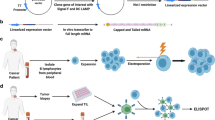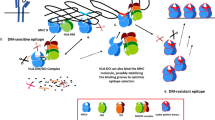Conclusions
In summary, the transfection of HLA class II sequences is proving a useful tool for various aspects of the analysis of antigen presentation. Such transfectants have been used in the generation of new polymorphic HLA mAbs and in mapping the specificities of existing mAbs. In terms of analysing the HLA restriction of particular T cell clones, transfectant APC are increasingly being used as a means of identifying the presenting class II molecule, a less equivocal approach than mAb blocking studies or presentation by B-LCL panels. Our studies with DR2-restricted clones showed that, as with other haplotypes which generate two DR products, one of the two expressed DRβ chains is functionally dominant. Once restricting molecules for interesting clones have been worked out, spe cific sites in the cDNA can be readily mutagenised to establish the areas of interaction between peptide, class II and TCR. On the more general question of APC function, transfected L cells are capable not only of presenting peptide antigens but also process complex antigens, suggesting that some of the degradative pathways necessary for processing are generally available in diverse cell types. The ability of transfectants to function as APC seems to extend, at least in some cases, to the presentation of allodeterminants. HLA class II transfected L cells which were poor at presenting either soluble antigen or allo-antigen to T cells owing to insufficient levels of class II expression could be made into potent APC by retransfection with ICAM-1, restoring the accessory molecule interaction between LFA-1 and ICAM-1. This approach is proving valuable in defining the role of such accessory molecules in antigen presentation. With the ability to generate powerful tools for the in vitro dissection of HLA function as well as the appearance of transgenic mice for in vivo studies, the coming years should yield exciting advances in understanding the complexities of antigen presentation in human immunity.
Similar content being viewed by others
References
Shimonkevitz, R.J.; Kappler, J.W.; Marrack, P.; Grey, H.: Antigen recognition by H-2-restricted T cells. I. Cell-free antigen processing. J. exp. Med.158: 303–316 (1983).
Babbitt, B.P.; Allen, P.M.; Matsueda, G.; Haber, E.; Unanue, E.R.: Binding of immunogenic peptides to Ia histocompatibility molecules. Nature317: 359–361 (1985).
Bell, J.I.; Denney, D.; Foster, L.; Belt, T.; Todd, J.A.; McDevitt, H.O.: Allelic variation in the DR subregion of the human major histocompatibility complex. Proc natn. Acad. Sci. USA84: 6234–6238 (1987).
Todd, J.A.; Bell, J.I.; McDevitt, H.O.: HLA-DQβ gene contributes to susceptibility and resistance to insulin-dependent diabetes mellitus. Nature329: 599–604 (1987).
Bugawan, T.L.; Horn, G.T.; Long, C.M.; Mickelson, E.; Hansen, J.A.; Ferrara, G.B.; Angelini, G.; Erlich, H.A.: Analysis of HLA-DP allelic sequence polymorphism using the in vitro enzymatic DNA amplification of DPα and DPβ loci. J. Immun.141: 4024–4031 (1988).
Bjorkmann, P.J.; Saper, M.A.; Samraoui, B.; Bennett, W.S.; Strominger, J.L.; Wiley, D.C.: The foreign antigen binding site. Nature329: 512–518 (1988).
Brown, J.H.; Jardetsky, T.; Saper, M.A.; Samraoui, B.; Bjorkman, P.J.; Wiley, D.C.: A hypothetical model of the foreign antigen binding site of class II histocompatibility molecules. Nature332: 845–847 (1988).
Davis, M.M.; Bjorkmann, P.J.: T cell antigen receptor genes and T cell recognition. Nature334: 395–401 (1988).
Austin, P.; Trowsdale, J.; Rudd, C.; Bodmer, W.; Feldmann, M.; Lamb, J.: Functional expression of HLA-DP genes transfected into mouse fibroblasts. Nature13: 61–64 (1985).
Wilkinson, D.; Altmann, D.M.; Ikeda, H.; Trowsdale, J.: Analysis of HLA-class II products by DNA-mediated gene transfer (in press).
Wilkinson, D.; de Vries, R.R.P.; Madrigal, J.A.; Lock, C.B.; Trowsdale, J.; Altmann, D.M.: Analysis of HLA-DR glycoproteins by DNA-mediated gene transfer. Definition of DR2β gene products and antigen presentation to T cell clones from leprosy patients. J. exp. Med.167: 1442–1458 (1988).
Ikeda, H.; Trowsdale, J.; Saito, I.: Mulcos: a vector for amplification and simultaneous expression of two foreign genes in mammalian cells. Gene71: 19–27 (1988).
Korman, A.J.; Frantz, J.D.; Strominger, J.L.; Mulligan, R.C.: Expression of human class II histocompatibility antigens using a retrovirus vector. Proc. natn. Acad. Sci. USA82: 2150–2153 (1987).
Kwok, W.W.; Schwarz, D.; Nepom, B.S.; Hock, R.A.; Thurtle, P.S.; Nepom, G.T.: HLA-DQ molecules form α-β heterodimers of mixed allotype. J. Immun.141: 3123–3127 (1989).
Lotteau, V.; Sands, J.; Teyton, L.; Turmel, P.; Charron, D.; Strominger, J.L.: Modulation of HLA class II antigen expression by transfection of sense and antisense DRα cDNA chain. J. exp. Med.169: 351–356 (1989).
Heyes, J.; Austin, P.J.; Bodmer, J.; Bodmer, W.F.; Madrigal, A.; Mazzilli, M.; Trowsdale, J.: Monoclonal antibodies to HLA-DP transfected mouse L cells. Proc natn. Acad. Sci. USA83: 3417–3421 (1986).
Young, J.A.T.; Lindsay, J.; Bodmer, J.G.; Trowsdale, J.: Epitope recognition by a DPα chain specific monoclonal anbitody (DP11.1) is influenced by the interaction between the DPα chain and its polymorphic DPβ chain partner. Hum. Immunol.23: 37–44 (1988).
Klohe, E.P.; Watts, R.; Bahl, M.; Alber, C.; Yu, W.-Y.; Anderson, R.; Silver, J.; Gregerson, P.K.; Karr, R.W.: Analysis of molecular specificities of anti-class II monoclonal antibodies by using L cell transfectants expressing HLA class II molecules. J. Immun.141: 2158–2164 (1988).
Eckels, D.D.; Woody, J.N.; Hartzman, R.J.: Monoclonal and xenoantibodies inhibit primary responses to HLA-DR but fail to inhibit secondary proliferative (PLT) responses to allogeneic cells. Hum. Immunol.3: 133–142 (1981).
Young, J.A.T.; Wilkinson, D.; Bodmer, W.F.; Trowsdale, J.: Sequence and evolution of HLA-DR7 and DRw53 associated β chains. Proc natn. Acad. Sci.84: 4929–4933 (1987).
Ozato, K.; Mayer, N.; Sachs, D.H.: Hybridoma cell lines secreting monoclonal antibodies to mouse H-2 and I-A antigens. J. Immun.124: 533–549 (1980).
Ziegler, A.B.; Uchanska-Ziegler, J.; Zeuthen, J.; Wernet, P.: HLA-antigen expression at the single cell level on a K562x B cell hybrid: an analysis with monoclonal antibodies using bacterial binding assays. Somatic Cell Genet.8: 775–789 (1982).
Lampson, L.A.; Levy, R.: Two populations of Ia-like molecules on a human B cell line. J. Immun.125: 293–299 (1980).
Rothbard, J.B.; Lechler, R.I.; Howland, K.; Bal, V.; Eckels, D.; Sekaly, R.; Long, E.O.; Taylor, W.R.; Lamb, J.R.: Structural model of HLA-DR1 restricted T cell antigen recognition. Cell52: 515–523 (1988).
Siliciano, R.F.; Lawton, T.; Knall, C.; Karr, R.W.; Berman, P.; Gregory, T.; Reinherz, E.L.: Host virus interaction in AIDS: analysis with human T cell clones reveals complexities of T cell receptor recognition and suggests a mechanism for CD4+ cell depletion. Cell54: 561–575 (1988).
Lamb, J.R.; Rees, A.D.M.; Bal, V.; Ikeda, H.; Wilkinson, D.; de Vries, R.R.P.; Rothbard, J.B.: Prediction and identification of an HLA-DR-restricted T cell determinant in the 19kDa protein ofM. tuberculosis. Eur. J. Immunol.18: 973–976 (1988).
Celis, E.; Karr, R.W.: Presentation of an immunodominant T cell epitope of hepatitis B surface antigen by the HLA-DPw4 molecule. J. Virol.63: 747–755 (1989).
Sekaly, R.P.; Jacobson, S.; Richert, J.R.; Tonnelle, C.; McFarland, H.F.; Long, E.O.: Antigen presentation to HLA class II-restricted measles virus-specific T cell clones can occur in the absence of the invariant chain. Proc natn. Acad. Sci. USA85: 1209–1212 (1988).
Eckels D.D.; Sell, T.W.; Long, E.O.; Sekaly, R.P.: Presentation of influenza hemagglutinin peptide in the presence of limited allostimulation by HLA-DR1 transfected human fibroblasts. Hum. Immunol.21: 173–181 (1988).
Shastri, N.; Malissen, B.; Hood, L.: Ia-transfected L cell fibroblasts present a lysozyme peptide but not the native protein to lysozyme-specific T cells. Proc. natn. Acad. Sci. USA82: 5885–5889 (1985).
Collins, T.; Korman, A.J.; Wake, C.T.; Boss, J.M.; Kappes, D.J.; Fiers, W.; Ault, K.A.; Gimbrone, M.A.; Strominger, J.L.; Pober, J.S.: Immune interferon activates multiple class II major histocompatibility complex genes and the associated invariant chain gene in human endothelial cells and the associated invariant chain gene in human endothelial cells and dermal fibroblasts. Proc. natn. Acad. Sci. USA81: 4917–4921 (1984).
Wagner, C.R.; Vetto, R.M.; Burger, D.R.: The mechanism of antigen presentation by endothelial cells. Immunobiology168: 453–469 (1984).
Botazzo, G.F.; Pujol-Borrell, R.; Hanafusa, T.; Feldmann, M.: Role of aberrant HLA-DR expression and antigen presentation by endothelial cells. Lancetii: 1115–1119 (1983).
Londei, M.; Lamb, J.R.; Bottazzo, G.F.; Feldmann, M.: Epithelial cells expressing aberrant MHC class II determinants can present antigen to cloned human T cells. Nature312: 639–641 (1984).
Markmann, J.; Lo, D.; Naji, A.; Palmiter, R.L.; Brinster, R.L.; Heber-Katz, E.: Antigen-presenting function of class II MHC expressing pancreatic beta cells. Nature336: 476–479 (1988).
Buus, S.; Sette, A.; Grey, H.M.: The interaction between protein-derived immunogenic peptides and Ia. Immunol. Rev.98: 115–141 (1987).
Matzinger, P.; Bevan, M.J.: Why do so many lymphocytes respond to major histocompatibility antigens? Cell. Immunol.29: 1–5 (1977).
Marrack, P.; Kappler, J.: T cells can distinguish between allogeneic major histocompatibility complex products on different cell types. Nature332: 840–843 (1988).
Cowan, E.P.; Coligan, J.E.; Biddison, W.E.: Human cytotoxic T lymphocyte recognition of an HLA-A3 gene product expressed on murine L cells: the only human gene product required on the target cell for lysis is the class I heavy chain. Proc. natn. Acad. Sci USA82: 4490–4494 (1985).
Barbosa, J.A.; Santos-Aguado, J.; Menzer, S.J.; Strominger, J.L.; Burakoff, S.J.; Biro, P.A.: Site directed mutagenesis of class I HLA genes: role of glycosylation in surface expression and functional recognition. Proc. natn. Acad. Sci. USA81: 7549–7553 (1984).
Bernhard, E.J.; Le, A.-X.T.; Yannelli, J.R.; Holterman, M.J.: Hogan, K.T.; Parham, P.; Engelhard, V.H.: The ability of cytotoxic T cells to recognize HLA-A2.1 or HLA-B7 antigens expressed on murine cells correlates with their epitope specificity. J. Immun.139: 3614–3621 (1987).
Nakatsuji, T.; Inoko, H.; Ando, A.; Sato, T.; Koide, T.; Tadakuma, T.; Yoshida, T.O.; Tsuji, K.: The role of transfected HLA-DQ genes in the mixed lymphocyte reaction-like condition. Immunogenetics25: 1–6 (1987).
Buss, S.; Sette, A.; Colon, S.M.; Grey, H.M.: Autologous peptides constitutively occupy the antigen-binding site on Ia. Science242: 1045–1047 (1988).
Matis, L.A.; Sorger, S.B.; McElligot, D.L.; Fink, P.J.: Hedrick, S.M.: The molecular basis of alloreactivity in antigen-specific, major histocompatibility complex restricted T cell clones. Cell51: 59–69 (1987).
Marlin, S.; Springer, T.A.: Purified intercellular adhesion molecule-1 (ICAM-1) is a ligand for lymphocyte function-associated antigen-1 (LFA-1). Cell51: 813–819 (1987).
Simmons, D.; Makgoba, M.W.; Seed, B.: ICAM, an adhesion ligand of LFA-1 is homologous to the neural cell adhesion molecule NCAM. Nature331: 624–627 (1988).
Springer, T.A.; Dustin, M.L.; Kishimoto, T.K.; Marlin, S.D.: The lymphocyte function associated LFA-1, CD2 and LFA-3 molecules: cell adhesion receptors of the immune system. Annu. Rev. Immunol.5: 223–252 (1987).
Gregory, C.D.; Murray, R.J.; Edwards, C.F.; Rickinson, A.B.: Downregulation of cell adhesion molecules LFA-3 and ICAM-1 in Epstein-Barr-virus-positive Burkitt’s lymphoma underlies tumor cell escape from virus-specific T cell surveillance. J. exp. Med.167: 1811–1824 (1988).
Barbosa, J.A.; Mentzer, S.J.; Kamarck, M.E.; Hart, J.; Biro, P.A.; Strominger, J.L.; Burakoff, S.J.: Gene mapping and somatic cell hybrid analysis of the role of human lymphocyte function-associated antigen-3 (LFA-3) in CTL-target cell interactions. J. Immun.136: 3085–3091 (1986).
Author information
Authors and Affiliations
Rights and permissions
About this article
Cite this article
Altmann, D.M., Wilkinson, D., Ikeda, H. et al. Analysis of antigen presentation using HLA transfectants. Immunol Res 9, 57–68 (1990). https://doi.org/10.1007/BF02918479
Issue Date:
DOI: https://doi.org/10.1007/BF02918479




